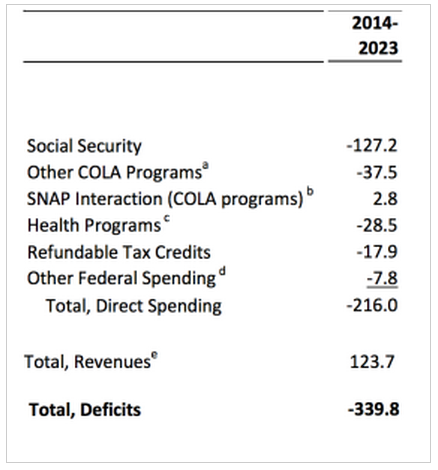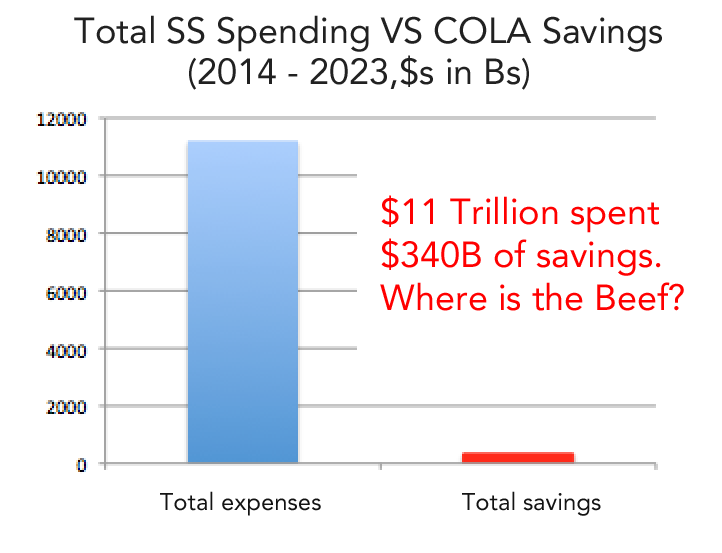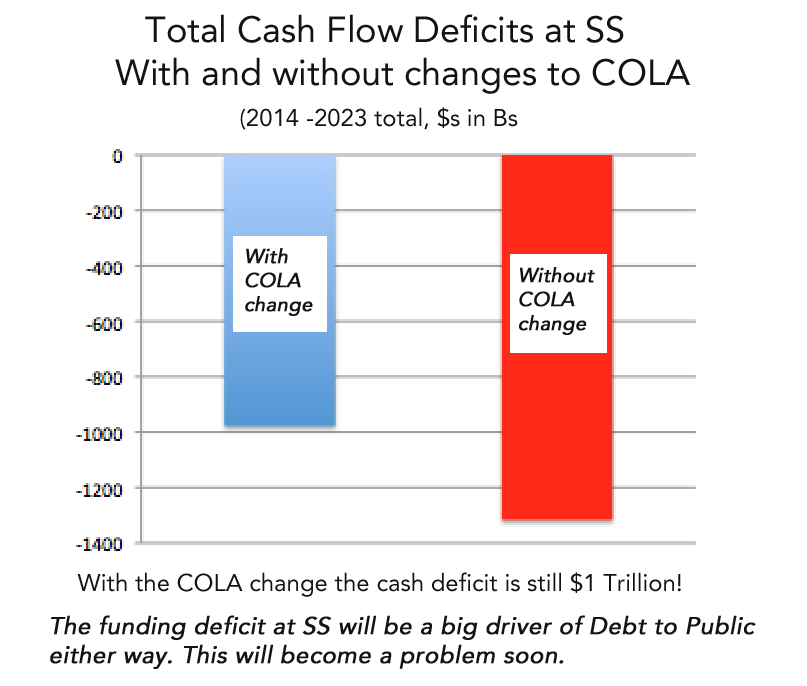The Congressional Budget Office (CBO) released a report that evaluates the consequences of adopting the chained CPI. I was surprised by the results. The numbers are “so good” that this approach will rise to the top of the budget cutting debate. I’m sure that was the intent of the folks at CBO with this timely release.
If America is going to accomplish anything with the debt/deficit issue it needs to either generate more revenue, or cut expenses. Some combo is going to be the outcome. The numbers have to be big. Anything less than $1T over ten years is hardly worth the effort. $2T would be desirable, but hard to achieve. Something around $1.5T over ten-years would take all the bull-shit over this issue off the front pages for a few years.
So we “need” $1.5T stretched out over a decade. The CBO concludes that we can come up with $340B (25%) of the nut by changing inflation calculations. That’s a big down payment. Some details:
Changing the CPI has consequences to both government revenues and expenses. Expenses, like Social Security and other retirement programs will be reduced from what is now scheduled. Tax revenues will rise as a result of the inflation adjustments on tax brackets, and changes to refundable tax credits under ACA. The breakdown:
For every dollar of increased revenue there is $1.7 dollars of expense cuts. Is this “fair”? I don’t know, but it isn’t unfair.
- 59% of the savings comes from reduced Social Security payments, while 17% of the reductions come from the retirement plans for the Military and Federal workers. The net reductions hit all of the government retirement programs equally, so this also seems fair.
- Adjustments to COLA will result in relatively small changes in early years. In 2014, the expense reduction is only $3.4B, in 2023 the reduction will be $70b. This a “desirable” outcome as those who will lose benefits will have a significant time to adjust to those changes.
- Most economists believe it would be a mistake to make sharp cuts in spending today. The consequences of adjusting COLA are consistent with what the economists “want”.
- If the changes in COLA were extended for another ten-years beyond 2023, the cost savings would get larger and larger. Over a 75-year period the changes in COLA would save trillions, but in 75 years a cup of coffee will cost $5,000, so I’m not sure what any of these big numbers really mean.
Having discussed why the changes in COLA are economically significant, its now time to look at what is wrong with this proposal.
- The AARP, the liberal press and many progressive politicians are going to hate this plan. The mantra “Don’t touch Social Security – it’s off budget!” is going to be heard again-and-again. Changes to COLA can only be accomplished as part of a broader plan. That plan must included changes to Medicare and Medicaid. It will require that more revenues (eliminate deductions) be part of the deal. I have a difficult time believing that a “big deal” can happen given the rancor in D.C. today.
- The Generals/Admirals and Federal workers are going to get clipped along with SS recipients. I see that as a big problem.
- In the CBO projections there is an assumed increase in SNAP costs. SNAP = Food Stamps. Why would Food Stamp costs go up if COLA is adjusted? The CBO answers this:
CBO estimates that the proposal would reduce income to individuals who also receive SNAP.
Aha! Poor people will get poorer as a result, and therefore they will qualify for more Food Stamps, so costs go up. This is an unintended consequence, but it is a dumb one. This demonstrates how difficult it is to actually “fix” problems.
- Adjustments in COLA represent across-the-board cuts. This is stupid. 70% of SS beneficiaries NEED the benefits they will get, 30% don’t. There is no “fairness” to that outcome. This may prove to be the fatal flaw of this proposal.
- The changes in the COLA formula should result in “positive” YoY changes. But there is no guarantee according to the CBO:
The actual difference in any year could vary noticeably from that average.
The estimates behind the “good” results are flaky. I hate it when that happens….
- The projected increase in revenue comes substantially from how the Affordable Care Act (ACA – Obamacare) will be “paid” for. But ACA doesn’t exist today. This means we were sold a bill of goods when ACA was invented.
Adjustments to COLA means that the cost of healthcare for all Americans will be higher than what has been previously projected. So the biggest changes in the US healthcare system in 50 years is put on (more) shaky legs when COLA changes are made. This is the Whack-A-Mole problem. When one problem is “fixed” it pops up someplace else and causes even bigger problems.
- The proposed changes to COLA have a significant consequence to SS beneficiaries. But compared to what is programed to be spent, the changes are a drop in the bucket. These charts tell the story: 

- To me, the issue of greatest concern is how SS will influence the Debt Owed to the Public. The following graph looks at the projected negative cash flow at SS with and without changes to COLA.

Conclusions:
Changes in COLA are coming – provided it is packaged with other measures that (A) decrease Medicare and Medicaid spending, (B) reduce military spending, (C) reduce other discretionary spending and (D) the elimination of many personal income tax deductions. What’s the probability of that package being realized from the current crop of legislators? Does Zero seem about right? I don’t see it happening.
Adjustments to COLA can add up to big numbers. But the numbers we are faced with are so large, the COLA changes are really just a rounding error.
- English (UK)
- English (India)
- English (Canada)
- English (Australia)
- English (South Africa)
- English (Philippines)
- English (Nigeria)
- Deutsch
- Español (España)
- Español (México)
- Français
- Italiano
- Nederlands
- Português (Portugal)
- Polski
- Português (Brasil)
- Русский
- Türkçe
- العربية
- Ελληνικά
- Svenska
- Suomi
- עברית
- 日本語
- 한국어
- 简体中文
- 繁體中文
- Bahasa Indonesia
- Bahasa Melayu
- ไทย
- Tiếng Việt
- हिंदी
COLA Changes: Pros And Cons
Published 03/03/2013, 02:00 AM
Updated 07/09/2023, 06:31 AM
COLA Changes: Pros And Cons
3rd party Ad. Not an offer or recommendation by Investing.com. See disclosure here or
remove ads
.
Latest comments
Install Our App
Risk Disclosure: Trading in financial instruments and/or cryptocurrencies involves high risks including the risk of losing some, or all, of your investment amount, and may not be suitable for all investors. Prices of cryptocurrencies are extremely volatile and may be affected by external factors such as financial, regulatory or political events. Trading on margin increases the financial risks.
Before deciding to trade in financial instrument or cryptocurrencies you should be fully informed of the risks and costs associated with trading the financial markets, carefully consider your investment objectives, level of experience, and risk appetite, and seek professional advice where needed.
Fusion Media would like to remind you that the data contained in this website is not necessarily real-time nor accurate. The data and prices on the website are not necessarily provided by any market or exchange, but may be provided by market makers, and so prices may not be accurate and may differ from the actual price at any given market, meaning prices are indicative and not appropriate for trading purposes. Fusion Media and any provider of the data contained in this website will not accept liability for any loss or damage as a result of your trading, or your reliance on the information contained within this website.
It is prohibited to use, store, reproduce, display, modify, transmit or distribute the data contained in this website without the explicit prior written permission of Fusion Media and/or the data provider. All intellectual property rights are reserved by the providers and/or the exchange providing the data contained in this website.
Fusion Media may be compensated by the advertisers that appear on the website, based on your interaction with the advertisements or advertisers.
Before deciding to trade in financial instrument or cryptocurrencies you should be fully informed of the risks and costs associated with trading the financial markets, carefully consider your investment objectives, level of experience, and risk appetite, and seek professional advice where needed.
Fusion Media would like to remind you that the data contained in this website is not necessarily real-time nor accurate. The data and prices on the website are not necessarily provided by any market or exchange, but may be provided by market makers, and so prices may not be accurate and may differ from the actual price at any given market, meaning prices are indicative and not appropriate for trading purposes. Fusion Media and any provider of the data contained in this website will not accept liability for any loss or damage as a result of your trading, or your reliance on the information contained within this website.
It is prohibited to use, store, reproduce, display, modify, transmit or distribute the data contained in this website without the explicit prior written permission of Fusion Media and/or the data provider. All intellectual property rights are reserved by the providers and/or the exchange providing the data contained in this website.
Fusion Media may be compensated by the advertisers that appear on the website, based on your interaction with the advertisements or advertisers.
© 2007-2024 - Fusion Media Limited. All Rights Reserved.